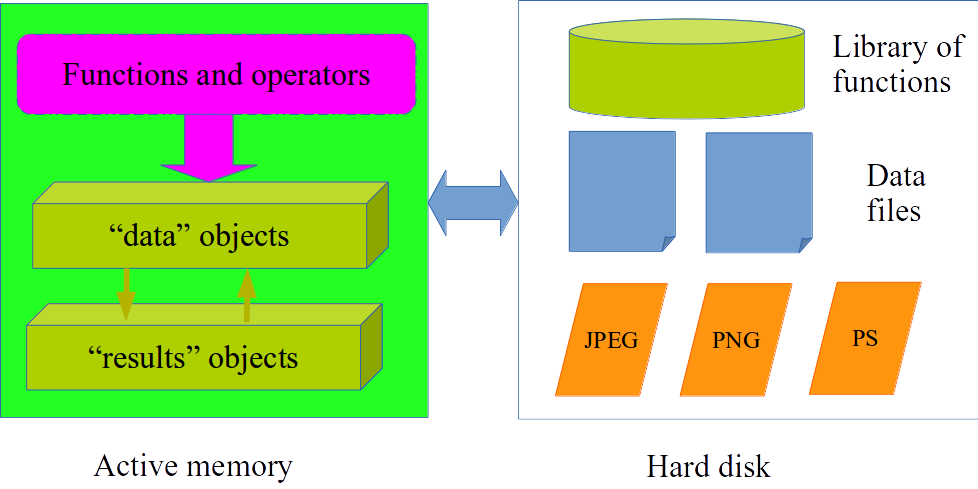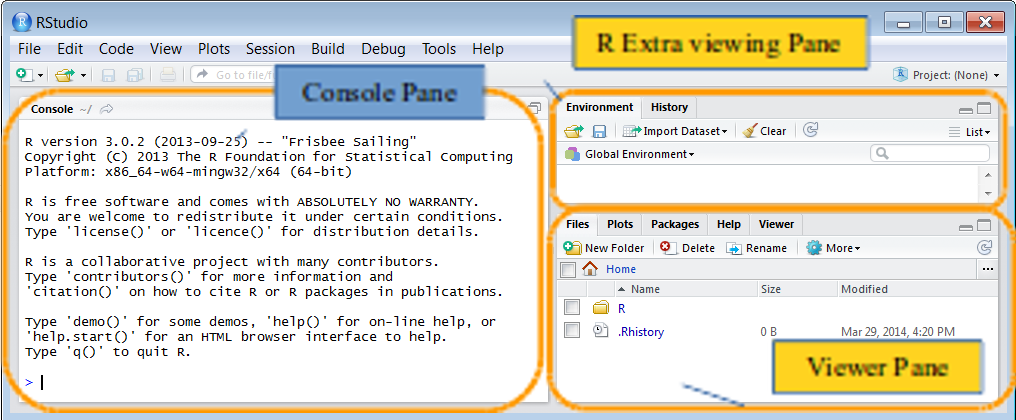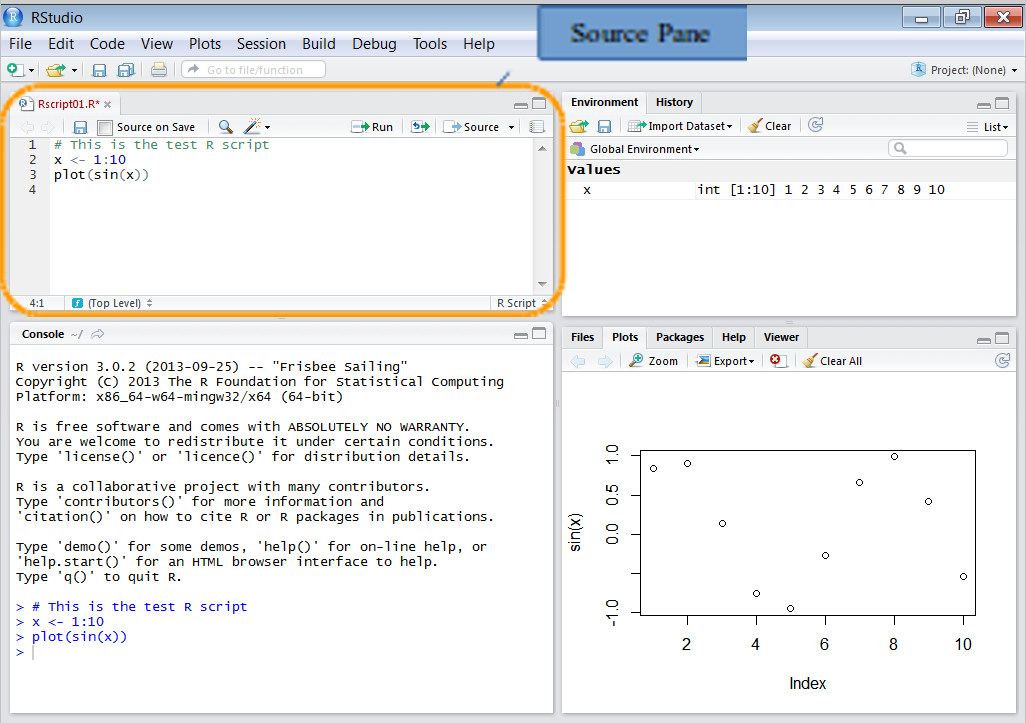R-studio tutorial
Krung Sinapiromsaran
October 2014
Outline
- R programming language
- R IDE
- R commands
- R Studio
- Console Pane
- Viewer Pane
- Extra viewing Pane
- Source Pane
R programming language
![]() is a computing environment, similar to matlab
is a computing environment, similar to matlab
- R is a high-level language based on scheme and S.
- R communicates to a user via
- console to execute one command at a time
- script to execute selection of R statements
- interactive to execute GUI commands
R history
- S language from Bell labs and became commercial as S-plus (http://www.insightful.com/) in 1988
- R is a combination of S and Scheme from Ross Ihaka and Robert Gentleman
- First announcement in 1993
- Official web address is http://www.r-project.org/
- October 2014:release 3.1.1
R data structures
- R is a dynamic type language.
- A variable in R can hold any type of data structures such as integer, double, character, boolean, vector, matrix, array, data.frame, list, etc.
- primitive type such as integer, double, character, boolean
- list type such as vector, list of objects
- array type such as matrix, array of more than 2 dimensions
- tabular type such as dataframe
R advantages
- Free
- Available on many platforms
- Excellent development team Apr/Oct release
- Source always available
- Fast for vectorized calculations
- Comprehensive R Archive Network (CRAN) ~ 1100 packages
- On-line documents with examples
- High-quality graphics
R workspace
- In each R session, variables, functions are stored in the active memory called workspace as objects.
- Operators and functions can be performed on these objects.
- To import/export data, a user needs read.* and write.* function
R architecture

R variables
N <- 15; N
[1] 15
Generate an object to keep integer 15 pointed by N.
5 -> n; n
[1] 5
R is case-sensitive, N and n are different variables. A user can use -> or <- to assign value to a variable.
R list
x <- c(3, 5, 7); x
[1] 3 5 7
Generate a list of integers using a function c().
y <- 1:30; y
[1] 1 2 3 4 5 6 7 8 9 10 11 12 13 14 15 16 17 18 19 20 21 22 23
[24] 24 25 26 27 28 29 30
A user can generate a vector of indices :. Note the bracket in front of the result [1] indicates the index of the first object to be printed.
R lists
x <- c(T, F, F); x
[1] TRUE FALSE FALSE
Generate a list of boolean values.
y <- c(1.2, 4.3, 10.1, 11.2); y
[1] 1.2 4.3 10.1 11.2
Generate a list of real numbers.
R IDE
R standard console (default)
R commander (R GUI required additional modules)
R studio (R GUI via browser offered both client and server)
RKWard (R Stand-alone GUI)
Other editors such as Emacs (http://ess.r-project.org/)
R commands
args(ls)
function (name, pos = -1L, envir = as.environment(pos), all.names = FALSE,
pattern)
NULL
- help(ls)
- Show help file for a function ls()
R sample commands
| Commands | Description |
|---|---|
| help.start() | Start the on-line help |
| help.search(“matrix”) | Search for “matrix” in R libraries |
| demo() | Start the R demonstration |
| q() | Exit the current session |
R example command
example(boxplot)
boxplt> ## boxplot on a formula:
boxplt> boxplot(count ~ spray, data = InsectSprays, col = "lightgray")
boxplt> # *add* notches (somewhat funny here):
boxplt> boxplot(count ~ spray, data = InsectSprays,
boxplt+ notch = TRUE, add = TRUE, col = "blue")
boxplt> boxplot(decrease ~ treatment, data = OrchardSprays,
boxplt+ log = "y", col = "bisque")
boxplt> rb <- boxplot(decrease ~ treatment, data = OrchardSprays, col = "bisque")
boxplt> title("Comparing boxplot()s and non-robust mean +/- SD")
boxplt> mn.t <- tapply(OrchardSprays$decrease, OrchardSprays$treatment, mean)
boxplt> sd.t <- tapply(OrchardSprays$decrease, OrchardSprays$treatment, sd)
boxplt> xi <- 0.3 + seq(rb$n)
boxplt> points(xi, mn.t, col = "orange", pch = 18)
boxplt> arrows(xi, mn.t - sd.t, xi, mn.t + sd.t,
boxplt+ code = 3, col = "pink", angle = 75, length = .1)
boxplt> ## boxplot on a matrix:
boxplt> mat <- cbind(Uni05 = (1:100)/21, Norm = rnorm(100),
boxplt+ `5T` = rt(100, df = 5), Gam2 = rgamma(100, shape = 2))
boxplt> boxplot(as.data.frame(mat),
boxplt+ main = "boxplot(as.data.frame(mat), main = ...)")
boxplt> par(las = 1) # all axis labels horizontal
boxplt> boxplot(as.data.frame(mat), main = "boxplot(*, horizontal = TRUE)",
boxplt+ horizontal = TRUE)
boxplt> ## Using 'at = ' and adding boxplots -- example idea by Roger Bivand :
boxplt>
boxplt> boxplot(len ~ dose, data = ToothGrowth,
boxplt+ boxwex = 0.25, at = 1:3 - 0.2,
boxplt+ subset = supp == "VC", col = "yellow",
boxplt+ main = "Guinea Pigs' Tooth Growth",
boxplt+ xlab = "Vitamin C dose mg",
boxplt+ ylab = "tooth length",
boxplt+ xlim = c(0.5, 3.5), ylim = c(0, 35), yaxs = "i")
boxplt> boxplot(len ~ dose, data = ToothGrowth, add = TRUE,
boxplt+ boxwex = 0.25, at = 1:3 + 0.2,
boxplt+ subset = supp == "OJ", col = "orange")
boxplt> legend(2, 9, c("Ascorbic acid", "Orange juice"),
boxplt+ fill = c("yellow", "orange"))
boxplt> ## more examples in help(bxp)
boxplt>
boxplt>
boxplt>
R system commands
- R uses the current working directory to read and write files.
getwd()
[1] "/media/krung/KrungPassport/Data/data2014/Projects/Seagate/TrainingTimeSeriesOct2014/RTraining/TimeSeries"
- setwd(“path”)
- Change the working directory to path
R Input/Output commands
- R writes data to a text file via write.table()
x <- 1:4
write.table(x, "x.dat")
- R reads data stored in text (ASCII) via read.table()
y <- read.table("x.dat"); y
x
1 1
2 2
3 3
4 4
R read functions
read.csv(file, header = TRUE, sep = ",", quote="\"", dec=".", fill = TRUE, comment.char="", ...)
read.csv2(file, header = TRUE, sep = ";", quote="\"", dec=",", fill = TRUE, comment.char="", ...)
read.delim(file, header = TRUE, sep = "\t", quote="\"", dec=".", fill = TRUE, comment.char="", ...)
read.delim2(file, header = TRUE, sep = "\t", quote="\"", dec=",", fill = TRUE, comment.char="", ...)
R scan function
scan(file = "", what = double(), nmax = -1,
n = -1, sep = "", dec = ".",
quote=if(identical(sep,"\n"))""else"'\"",
skip = 0, nlines = 0, na.strings = "NA",
flush = FALSE, fill = FALSE,
strip.white = FALSE,
quiet = FALSE, blank.lines.skip = TRUE,
multi.line = TRUE, fileEncoding = "",
comment.char = "", allowEscapes = FALSE,
encoding = "unknown", text)
mydata<-scan("data.dat", what=list("", 0, 0))
R write function
write.table(x, file = "", append = FALSE,
quote = TRUE, sep = " ",
eol = "\n", na = "NA", dec = ".",
row.names = TRUE,
col.names = TRUE,
qmethod = c("escape", "double"),
fileEncoding = "")
write(x, file="data.txt")
R object creation
v1 <- as.vector(1:10, mode="double"); class(v1); v1
[1] "numeric"
[1] 1 2 3 4 5 6 7 8 9 10
lv <- factor(1:3); lv
[1] 1 2 3
Levels: 1 2 3
R matrix
m1 <- matrix(1:10, nrow=3, ncol=3); m1
[,1] [,2] [,3]
[1,] 1 4 7
[2,] 2 5 8
[3,] 3 6 9
Generate a matrix of \( 3 \times 3 \) from a list of numbers 1 to 10
R array
a1 <- array(1:10, c(2, 3, 2)); a1
, , 1
[,1] [,2] [,3]
[1,] 1 3 5
[2,] 2 4 6
, , 2
[,1] [,2] [,3]
[1,] 7 9 1
[2,] 8 10 2
Generate an array of \( 2 \times 2 \times 2 \) from a list of 1 to 10 and reused elements from 1 to 10.
R data frame
- R data frame is implicitly created via read() functions or a user can use a data.frame() function to generate it.
id <- c(1022, 1203, 2101)
name <- c("Narudom", "Kantarat", "Sathit")
d1 <- data.frame(id, name); d1
id name
1 1022 Narudom
2 1203 Kantarat
3 2101 Sathit
R list
- R list can contains any data types as its component.
id <- c(1022, 1203, 2101)
name <- c("Narudom", "Kantarat", "Sathit")
l1 <- list(id, name, d1); l1
[[1]]
[1] 1022 1203 2101
[[2]]
[1] "Narudom" "Kantarat" "Sathit"
[[3]]
id name
1 1022 Narudom
2 1203 Kantarat
3 2101 Sathit
R user defined object
- R also allows a user to create their own object
ts1 <- ts(c(1203, 3012, 4120, 2310), frequency=1)
ts1
Time Series:
Start = 1
End = 4
Frequency = 1
[1] 1203 3012 4120 2310
R useful functions
z <- rep(c(2,1), 4); z
[1] 2 1 2 1 2 1 2 1
Generate a list of 8 elements
w <- seq(from=-1,to=1,by=0.2); w
[1] -1.0 -0.8 -0.6 -0.4 -0.2 0.0 0.2 0.4 0.6 0.8 1.0
Generate a sequences of elements from -1 to 1 incremented by 0.2
R expression
- R allows a user to add two unequal-sized vectors. It will recycle elements from the smaller sized vector.
z + w
[1] 1.0 0.2 1.4 0.6 1.8 1.0 2.2 1.4 2.6 1.8 3.0
w + (1:3)
[1] 0.0 1.2 2.4 0.6 1.8 3.0 1.2 2.4 3.6 1.8 3.0
R arithmetic functions
| Commands | Description |
|---|---|
| sum(x) | Sum of elements of x |
| prod(x) | Product of elements of x |
| max(x) | Return the largest element of x |
| min(x) | Return the smallest element of x |
| which.max(x) | Return the index of the greatest element of x |
| which.min(x) | Return the index of the smallest element of x |
| length(x) | Return the number of elements of x |
R statistical functions
| Commands | Description |
|---|---|
| range(x) | Return a vector of the minimum and maximum of x |
| mean(x) | The arithmetic mean of x |
| median(x) | The median of x |
| var(x) | The variance of x |
| cor(x) | The correlation matrix of x |
R functions dealing with a list
| Commands | Description |
|---|---|
| pmin(x, y, …) | A vector which ith element is the minimum of x[i], y[i], … |
| pmax(x, y, …) | A vector which ith element is the maximum of x[i], y[i], … |
| cumsum(x) | A vector which ith element is the sum from x[1] to x[i] |
| cumprod(x) | A vector which ith element is the product from x[1] to x[i] |
| cummin(x) | A vector which ith element is the minimum from x[1] to x[i] |
| cummax(x) | A vector which ith element is the maximum from x[1] to x[i] |
R functions
| Commands | Description |
|---|---|
| round(x, n) | Rounds the elements of x to n decimals |
| rev(x) | Reverse elements of x |
| sort(x) | Sorts elements of x in increasing order |
| log(x, base) | Computes logarithm of x with base |
| choose(n, k) | Compute the combinations of k events amoung n repetitions |
| na.omit(x) | Suppress the observations with missing data (NA) |
| na.fail(x) | Return an error message if x contains at least one NA |
R functions dealing matrix
| Commands | Description |
|---|---|
| scale(x) | If x is a matrix, centers and reduces the data |
| match(x, y) | Return a vector of the same length as x with the element of x which are in y |
| which(x == a) | Return a vector of the indices of x if the comparison operation is true. |
| table(x) | Return a table with the numbers of different values of x |
| table(x, y) | Contingency table of x and y |
R other functions
| Commands | Description |
|---|---|
| subset(x, …) | Return a selection of x with respect to criteria |
| sample(x, size) | Resample randomly and without replacement size elements in the vector x |
| unique(x) | If x is a vector or a data frame, returns a similar object without duplication |
R plot
R Studio
![]()
- R Studio is a Window application that composes of the standard window components.
- Control box
- Title bar
- Menu bar
- R Studio server will interact with a user via the browser software
R Studio main window

- Console Pane shows the R command box
- Viewer Pane shows Files/Plots/Packages/Help/Viewer
- Extra viewing Pane shows Environment/History/Presentation
R Studio main window

- Source Pane appears when a user selects new command.
R Studio plot sin function
plot(sin, -3*pi, 3*pi)
R Studio plot with options
plot(sin,-3*pi,3*pi,type="l",col="red",lwd=5)
title("Plot sin from -3 pi to 3 pi")
R Studio plot
y <- c(3.1, 4.2, 2.1, 3.2, 4.2, 5.1)
plot(y, type="b", col="blue", lwd=5)
title("Plot y from data")
Summary
- A user learns how to write R statements.
- There are a lot of R IDEs available such as R Studio.
- R has many primitive data types and a user can generate combination of them easily
- R Studio composes of four extra panes
- Console pane
- Viewer pane
- Extra viewing pange
- Source pane